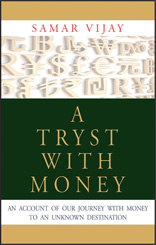
WHEN THIS BOOK was first handed to me, I was surprised by its audacity. “Tryst with Money” sounds like the proverbial BHAG ( Big Hairy Audacious Goal) that we hear about so many times in the corporate world; and that too in a mere 200-or-so pages?
Nah, I thought. This doesn’t look right.
With this scepticism, I started out.
True to expectations, I was bored in the first 10 pages and went to sleep. Really!
It starts slow and tries to paint money as the root of all evils (like we don’t know).
Gathering courage the next day, I moved on and so did the book to the barter system, the trade and commerce in ancient India and Greece — with some interesting anecdotes and theories — and then to the medieval age and emergence of banking system in Europe and rest of the world.
Here the book gathers steam and starts to settle in.
The transition is largely effortless, but does breaks off at some places and leaves more explanation desired -- the timelines while transitioning could have helped and also spiced up a little by including some quotes by the great men of finance.
The book tries to be a brief timeline of the world economy — a decidedly ambitious target (set out in the title itself). It does attempt that by covering almost every terminology in the world of finance and commerce. Right from barter, options, gold standard, black money to insurance, recession and GDP, it touches all and gives a good introduction to each of the aforementioned jargon to the man who doesn’t normally read the pink dailies and is a newcomer to the world of money. In fact, I feel the author wants us to read more on the topics ourselves and develop a thought.
Therein is its greatest victory.
By painting money as the common enemy, it forces the uninitiated reader to think momentarily about the “big” picture, about the role of money in human lives and our society. It makes us question where we are headed, especially in the uncertain times of today, after being aware of the potential blind spots.
Ultimately, the reader is forced to put the book down at some points and search the internet to whet his curiosity about a particular topic of interest.
This book is not un-putdown-able — in fact, it is intended to be putdown-able — only to be picked up again. This book should be read at least twice — once for consumption and then for digestion — to really get its true flavours out.
All in all, a sincere attempt — more of such are needed.
